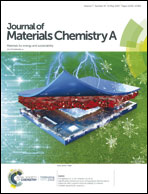Transition metal-embedded two-dimensional C3N as a highly active electrocatalyst for oxygen evolution and reduction reactions†
Abstract
Searching for highly efficient, stable and cost-effective catalysts for oxygen evolution reaction (OER) and oxygen reduction reaction (ORR) is vital to resolve energy security and environmental problems. Herein, by means of computational screening based on the density functional theory (DFT), we studied a wide range of transition metal (TM) atoms embedded into the double carbon vacancy of C3N monolayers (VCC), denoted as TM-VCC (TM = Mn, Fe, Co, Ni, Cu, Ru, Rh, Pd, Ir and Pt), as efficient single-atom catalysts (SACs) for OER and ORR. The calculated results showed that all the considered TM-VCC composites exhibited a metallic feature that ensured efficient charge transfer during reactions. The interaction strength between intermediates and TM-VCC has direct correlation with the d-band center of TM, which can be tuned by changing the TM atoms with different numbers of d electrons. The best catalyst for OER was Rh-VCC with an overpotential (ηOER) of 0.35 V, followed by Co-VCC (0.43 V). For the ORR process, Rh-VCC exhibited the lowest ORR overpotential (ηORR) of 0.27 V, followed by Co-VCC (0.42 V). The results suggested that the performances of the newly predicted Rh-VCC and Co-VCC SACs are comparable to those of the noble-metal benchmark catalysts for OER and ORR. Ab initio molecular dynamic simulations indicated that Rh-VCC and Co-VCC SACs could remain stable under 300 K and possessed high energy barriers to prevent the isolated Rh and Co atoms from clustering. Our results highlight a new family of efficient and stable catalysts with a single atom anchored on carbon nitride-based materials, which provides a useful guideline for catalyst design and practical applications.

- This article is part of the themed collection: 2019 Journal of Materials Chemistry A Most Popular Articles


 Please wait while we load your content...
Please wait while we load your content...
